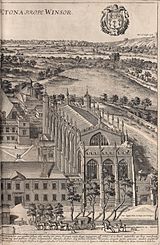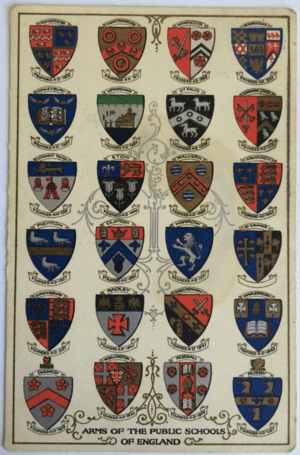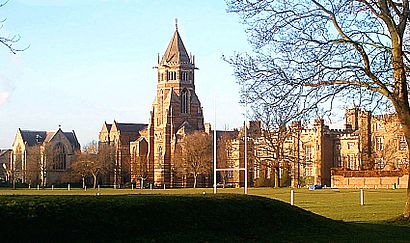Public school (United Kingdom) facts for kids
A public school in England and Wales (but not Scotland) is a fee-charging endowed school originally for older boys that was "public" in the sense of being open to pupils irrespective of locality, denomination or paternal trade or profession. Although the term "public school" has been in use since at least the 18th century, its usage was formalised by the Public Schools Act 1868, which put into law most recommendations of the 1864 Clarendon Report. Nine prestigious schools were investigated by Clarendon (including Merchant Taylors' School and St. Paul's School) and seven subsequently reformed by the Act: Eton, Shrewsbury, Harrow, Winchester, Rugby, Westminster, and Charterhouse.
Public schools have had a strong association with the ruling classes. Historically, the sons of officers and senior administrators of the British Empire were educated in English public schools whilst their fathers were on imperial postings. In 2019, two-thirds of cabinet ministers of the United Kingdom had been educated at such fee-charging schools, although a slim majority of cabinet ministers since 1964 were educated at state schools.
Contents
Definition
According to the Independent Schools Information Service – a consortium set up by British independent schools to promote themselves to the public – the term "public school" is:
...usually applied to describe the 215 independent and mainly boys' secondary schools belonging to the Headmasters' Conference. The name dates back to the time when schools founded for local children went 'public' and admitted children from further afield. It is also used to describe the some 230 girls' senior schools belonging to the Girls' Schools Association.
History

Origins
Until the late medieval period most schools were controlled by the church and had specific entrance criteria; others were restricted to the sons of members of guilds, trades or livery companies. The need for professional trades in an increasingly secularised society required schools for the sons of the gentry that were independent from ecclesiastical authority and open to all. From the 16th century onward, boys' boarding schools were founded or endowed for public use. Traditionally, most of these public schools were all boys and full boarding.
Separate preparatory schools (or "prep schools") for younger boys developed from the 1830s, with entry to the senior schools becoming limited to boys of at least 12 or 13 years old. The first of these was Windlesham House School, established with support from Thomas Arnold, headmaster of Rugby School.
Many of the schools, including Rugby School, Harrow School and the Perse School fell into decline during the 18th century and nearly closed in the early 19th century. Protests in the local newspaper forced governors of the Perse School to keep it open, and a court case in 1837 required reform of the abuse of the school's trust.

- 1. Tonbridge
- Charterhouse
- Winchester
- Bedford
- 2. Haileybury
- Uppingham
- St Paul's
- Manchester Grammar
- 4. Repton
- Clifton
- Harrow
- St Edwards
- 5. Shrewsbury
- Radley
- Cheltenham
- Marlborough
- 6. Dulwich
- Wellington
- Rossall
- Rugby
Victorian period
A Royal Commission, the Clarendon Commission (1861–1864), investigated nine of the more established schools, including seven boarding schools (Charterhouse, Eton, Harrow, Rugby, Shrewsbury, Westminster and Winchester) and two day schools (St Paul's and the Merchant Taylors').
The Public Schools Act 1868 regulated and reformed these "public schools", for which it provided the first legal definition: schools which were open to the paying public from anywhere in the country, as opposed to, for example, a local school only open to local residents, or a religious school open only to members of a certain church. St Paul's School and the Merchant Taylors' School claimed successfully that their constitutions made them "private" schools, and were excluded from the requirements of this legislation.
In 1887 the Divisional Court and the Court of Appeal determined that the City of London School was a public school.
Following the Clarendon Commission, the Taunton Commission was appointed to examine the remaining 782 endowed grammar schools, and produced recommendations to restructure their endowments; these recommendations were included, in modified form, in the Endowed Schools Act 1869. In that year, the headmaster of Uppingham School wrote to 37 other headmasters of what he considered leading boys' schools not covered by the Public Schools Act, inviting them to meet annually to address the threat posed by the Endowed Schools Act. In the first year only 12 headmasters attended, but in the following year 34 did, including the Clarendon schools. The Headmasters' Conference (HMC, now the Headmasters' and Headmistresses' Conference) has since grown steadily to over 200 schools.
The Public Schools Yearbook was published for the first time in 1889, listing 30 schools, mostly boarding schools except for St Paul's School and Merchant Taylors' School. Some academically successful grammar schools were added in later editions. The 1902 edition included all schools whose principals qualified for membership of the Headmasters' Conference.
1901–1959
The Fleming Report (1944) defined a public school as a member of the Governing Bodies Association or the Headmasters' Conference. Based on the recommendations of this report, the Education Act 1944 offered a new status to endowed grammar schools receiving a grant from central government. The direct grant grammar school would receive partial state funding in return for taking between 25% and 50% of its pupils from state primary schools. Members of the HMC accounted for 58 of the 178 direct grant schools, of which the vast majority were day schools. On average, nearly half of their places were funded by the state.
The Fleming Committee recommended that one-quarter of the places at public schools should be assigned to a national bursary scheme for children who would benefit from boarding. The key advocate was Ellen Wilkinson, but it got off to a slow start in an age of severe budget constraints. The Conservative Government elected in 1951 did not expand the programme. It failed because it was not a high priority for either party, money was tight, there was wavering support from independent boarding schools and local education authorities, and no consensus was reached on how to select the pupils to participate.
1960s–present
The 1960s were a time of considerable social change, and also of student activism. Civil unrest in France in May 1968, which started with student strikes, quickly escalated to the point that President Charles De Gaulle fled the country. In the UK students protested outside the US Embassy against the Vietnam War and staged sit-ins at the London School of Economics and elsewhere. The 1968 film if...., which satirised the worst elements of English public school life, and culminated in scenes of armed insurrection, won the Palme d'Or at the 1969 Cannes Film Festival. These actions were felt in British public schools; the new headmaster at Oundle School noted that "student protests and intellectual ferment were challenging the status quo". These challenges coincided with the mid-1970s recession and moves by the Labour government to separate more clearly the independent and state sectors.
Many boarding schools started to admit day pupils for the first time, and others abolished boarding completely. Some started accepting girls in the sixth form, while others became fully co-educational. The system of fagging, whereby younger pupils were required to act to some extent as personal servants to the most senior boys, was phased out during the 1970s and 1980s. Corporal punishment, which was outlawed in state schools in 1986, had been abandoned in most public schools by the time it was formally banned in independent schools in 1999 for England and Wales (2000 in Scotland and 2003 in Northern Ireland).
When the direct grant was abolished in 1975, the HMC schools within the scheme became fully independent. At the same time, local authorities were ordered to cease funding places at independent schools, which accounted for over 25% of places at 56 schools, and over half at 22 of them. In addition, between 1975 and 1983 various local authorities withdrew funding from 11 voluntary-aided grammar schools, which became independent schools and full members of the HMC. The loss of state-funded places at all of these schools, coinciding with the recession, put them under severe financial strain, and many became co-educational in order to survive. The direct grant was partially revived between 1981 and 1997 in the Assisted Places Scheme, which provided support for 80,000 pupils attending private schools.
More than half of HMC schools are now either partially or fully co-educational; of the Clarendon nine, two admit girls to the sixth form only, two are fully co-educational (Rugby and Shewsbury) and five retain the full-boarding, boys-only tradition: Eton College, Sherborne School, Radley College, Winchester College and Harrow School. The newest public school to join the HMC is Yarm School, which was founded in 1978.
The majority of public schools are affiliated with, or were established by, a Christian denomination, principally the Church of England, but in some cases the Roman Catholic and Methodist churches; or else identify themselves as "non-denominational Christian". A small number are inherently secular, most notably Oswestry School.
Associations with the ruling class

Up to World War II, the role of public schools in preparing pupils for the gentlemanly elite meant that such education, particularly in its classical focus and social mannerism, became a mark of the ruling class. For three hundred years, the officers and senior administrators of the British Empire usually sent their sons back home to boarding schools for education as gentlemen, often for uninterrupted periods of a year or more at a time. The 19th-century public school ethos promoted ideas of service to Crown and Empire, understood by the broader public in familiar sentiments such as "it's not whether you win or lose, it's how you play the game" and "the Battle of Waterloo was won on the playing fields of Eton" – the latter sometimes but probably wrongly attributed to Wellington. Many ex-pupils, like those from other schools, had, and still have, a nostalgic affection for their old schools (George Orwell remembered being "interested and happy" at Eton,) and a public school tie and "old boy network" of former pupils could be useful in a career. The English public school model influenced the 19th-century development of Scottish private schools, but a tradition of the gentry sharing primary education with their tenants kept Scotland comparatively egalitarian.
Postwar social change has gradually been reflected across Britain's educational system, while at the same time fears of problems with state education have pushed some parents, who can afford the fees or whose pupils qualify for bursaries or scholarships, towards public schools and other schools in the independent sector. In 2009 typical fees were up to £30,000 per annum for boarders.
As of 2015 Prime Minister David Cameron (Eton) and Chancellor of the Exchequer George Osborne (St Paul's) were both educated at Clarendon schools. While the outgoing Conservative Prime Minister in 1964 {Douglas-Home) had been educated at Eton College and the incoming Labour Prime Minister in 1997 (Blair) had been at Fettes College, all six British Prime Ministers in office between 1964 and 1997 and 2007 to 2010 were educated at state schools (Wilson, Heath, Thatcher and Major at grammar schools and Callaghan and Brown at other state secondary schools). Prime Minister Theresa May's secondary school education also was primarily in the state sector.
While members of the aristocracy and landed gentry no longer dominate independent schools, several studies have shown that such schools still retain a degree of influence over the country's professional and social elite despite educating less than 10% of the population. A 2012 study published by the Sutton Trust noted that 44% of the 7,637 individuals examined whose names appeared in the birthday lists of The Times, The Sunday Times, The Independent or The Independent on Sunday during 2011 – across all sectors, including politics, business, the arts and the armed forces – were educated at independent or private schools. It also found that 10 elite fee-paying schools (specifically Eton, Winchester, Charterhouse, Rugby, Westminster, Marlborough, Dulwich, Harrow, St Paul's, Wellington) produced 12% of the leading high-flyers examined in the study. The Social Mobility and Child Poverty Commission came to a similar conclusion in a 2014 study of the professions: 71% of senior judges, 62% of senior armed forces officers, 55% of Whitehall permanent secretaries and 50% of members of the House of Lords had been privately educated.
Comparisons with prisons
Public schools (especially boarding schools) have sometimes been light-heartedly compared by their pupils or ex-pupils to prisons. O. G. S. Crawford stated that he had been "far less unhappy" when incarcerated in Holzminden prisoner-of-war camp during the First World War than he had previously been at his public school, Marlborough College. Evelyn Waugh observed in his satirical novel Decline and Fall (1928) that "anyone who has been to an English public school will always feel comparatively at home in prison". Former Cabinet Minister Jonathan Aitken, sentenced to 18 months' imprisonment for perjury in 1999, commented in an interview: "As far as the physical miseries go, I am sure I will cope. I lived at Eton in the 1950s and I know all about life in uncomfortable quarters."
See also
 In Spanish: Public school para niños
In Spanish: Public school para niños


